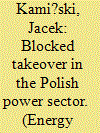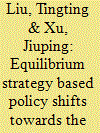| Srl | Item |
| 1 |
ID:
127869


|
|
|
|
|
| Publication |
2014.
|
| Summary/Abstract |
As the President of the Office of Competition and Consumer Protection refused to approve a government initiated takeover in the Polish power sector and the Court of Competition and Consumer Protection did not make a ruling on that case, the takeover was finally prohibited. In this context, the main aim of this paper is to carry out a quantitative analysis of the impact of the takeover in question on electricity prices and quantities, consumer and producer surpluses, dead weight loss and emissions. The scope of the study covers the Polish power generation sector and the analysis was carried out for 2009. A game theory-based electricity market equilibrium model developed for Poland was applied. The model includes several country-specific conditions, such as a coal-based power generation fuel-mix, a large share of biomass co-combustion, etc. For the sake of clarity, only four scenarios are assumed. The paper concludes that the declared synergy savings did not compensate for the increase in dead weight loss and the transfer of surplus from consumers to producers caused by increased market power.
|
|
|
|
|
|
|
|
|
|
|
|
|
|
|
|
| 2 |
ID:
180164


|
|
|
|
|
| Summary/Abstract |
As part of China's power industry reforms, developing appropriate market designs for the inclusion of renewable energy in the electricity spot market has been an ongoing challenge. This paper examined the effects of different market rules on wind power producer behavior to identify the policy implications for a renewable-friendly spot market, for which a market equilibrium model was developed to assess power transactions in the day-ahead and balancing markets, with the upper level being wind power producers seeking the best profits, and the lower level being the market clearing process to minimize generation costs. A case study is given, in which different scenarios are explored to assess the effects of bidding regulations and imbalance pricing mechanisms and to simulate the rising wind penetration in power systems. It was found that in the region modeled: more relaxed bidding regulations could provide wind producers incentives by allowing more profitable strategies; the imbalance pricing settings influence market results and producer revenues; and lower spot prices and power generation costs occur if a larger wind share was fed into the power system and could result in a unit revenue decline. Therefore, new policy directions are needed for the development of China's renewable-friendly electricity markets.
|
|
|
|
|
|
|
|
|
|
|
|
|
|
|
|